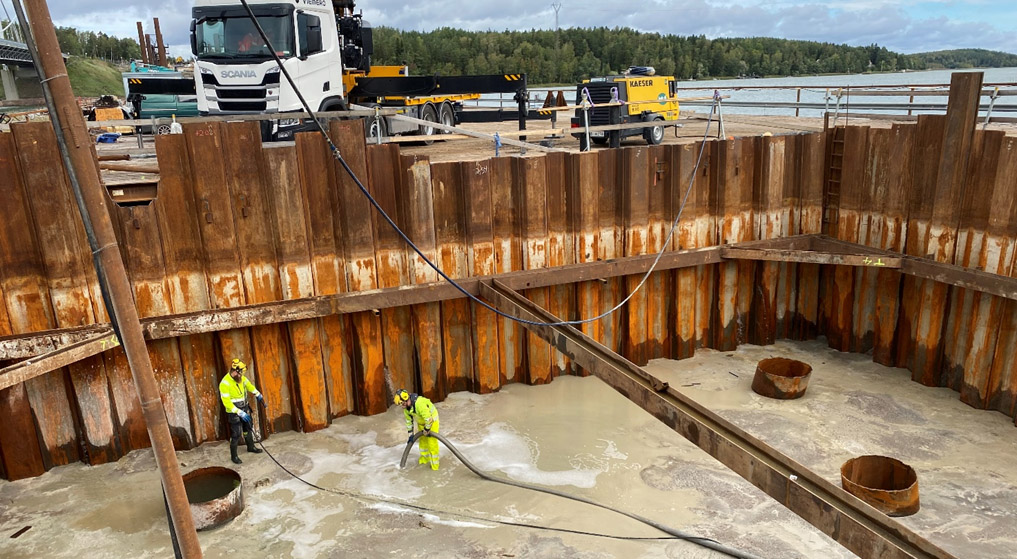Image: Pumping water out of a sheet pile cofferdam in early autumn 2023. The rust marks on the wall indicate the sea level outside the cofferdam.
Through their work, the bridge engineers Antti Rytkönen and Jari Nikki from the Finnish Transport Infrastructure Agency's Engineering Structures unit see a wide range of transport infrastructure projects. When building or repairing bridges or other engineering structures, they are involved in guiding construction planning and facilitating the progress of the project for their part.
Both Nikki and Rytkönen are currently taking part in the renovation of the Kirjalansalmi and Hessundinsalmi bridges on Highway 180. For both of them, this is one of the largest projects they have been involved in on their careers. The renovation of the two major bridges will secure the preservation of the only road connection to Parainen and the Turku archipelago.
“This is also a key project on my career. You don’t get a chance to participate in a project of this size and complexity very often,” Nikki says.
In the project, a cable-stayed bridge will be built across Kirjalansalmi strait. It will be nearly 700 metres long in total, with the longest span being 265 metres. The bridge being built across Hessundinsalmi strait will be more than 200 metres long, with the longest span being approximately 100 metres.
“When completed, the Kirjalansalmi bridge will be the bridge with the longest spans in Finland. At least from the viewpoint of a bridge engineer, it is the span length in particular, or the part between the supports, that is the most interesting measure. It is easy to place several short-span structures one after another, but it is harder to construct one long span,” says Rytkönen.
Cofferdam keeps the site dry
When building bridges over waterways, some of the work is often also carried out below the water level. The building of bridge substructures under the water level includes such actions as constructing the foundations by driving piles and laying the base foundation. The pylons rising from the base foundation are partly underwater.
Underwater construction is particularly demanding form of construction that requires solid professional skills and specific working methods. “You often hear people say that building becomes easier when you rise above the water level. Under the water level, all work is more difficult, more expensive and slower than working above the water,” Jari Nikki says.
On the construction sites of Kirjalansalmi and Hessundinsalmi bridges, the work below the water level has largely been carried out either sheltered by cofferdams or by diving. A cofferdam is a watertight enclosure used for the duration of construction to enable working under the water level. In other words, the cofferdam keeps the water outside the working area and the workers' feet dry.
Cofferdams also enable the casting of structures that are completely or partially underwater as ‘dry work’, i.e., as normal concrete pour. In the Kirjalansalmi bridge, these include the foundation poured on the bottom of the cofferdam, some of the bridge's footings and bored piles that distribute the bridge loads and stresses.
“Concrete self-consolidates, or hardens, also in water, which is why pouring is also possible below the water level. A bridge engineer tends to strive for as long uniform structures as possible and spanning an obstacle with a single bridge opening. Sometimes, however, it is more expedient with a view to the whole bridge to build intermediate supports for the bridge in the water,” Antti Rytkönen says.
Occupational safety priority number one in diving work
Not all construction below the water level can be done sheltered by a cofferdam. Instead, some of it must be done by diving. Occupational safety is always important, but it requires special attention when the work is carried out by diving. The improvement of safety regulations over time and advanced work equipment have enhanced the safety of diving work.
In Finland, water bodies are murky, which makes diving work considerably more difficult. In practice, divers must often perform their work almost in total darkness, using their sense of touch and different technologies.
“Underwater laser scanning is a modern imaging method that provides a good ‘picture’ of the contours of underwater structures, bottom features, and possible damage. Such material provides much more information about a dive than a customary review video of diving work. There you can mainly see a dark screen, while listening to the diver puffing and panting,” Nikki says and laughs.
The diving work done when renovating the Kirjalansalmi and Hessundinsalmi bridges has included different cable and bottom surveys, finishing the reinforcement work and preparation required for various work stages, such as welding stiffening frames for the cofferdam pilings. In addition, divers have been needed for assessing the nature of the bottom. When doing underwater pouring, the divers have ensured that the drop chute remains in the concrete all the time.

